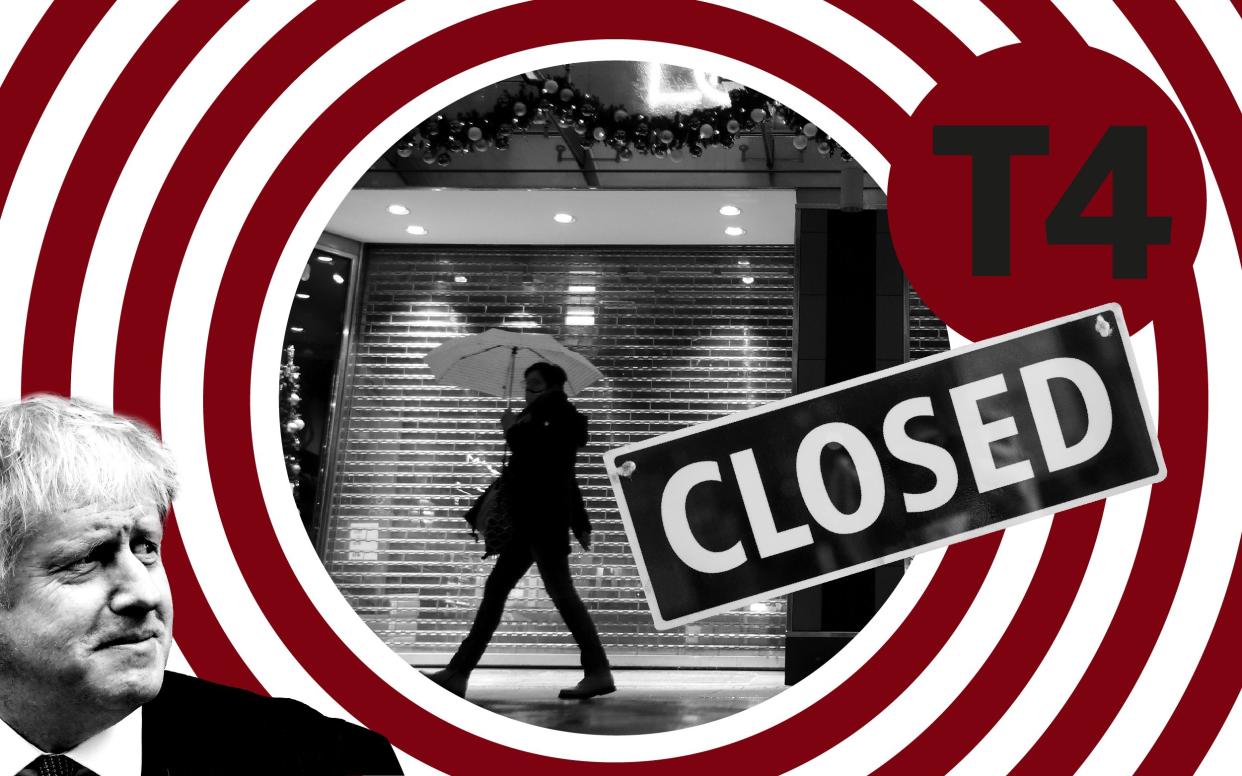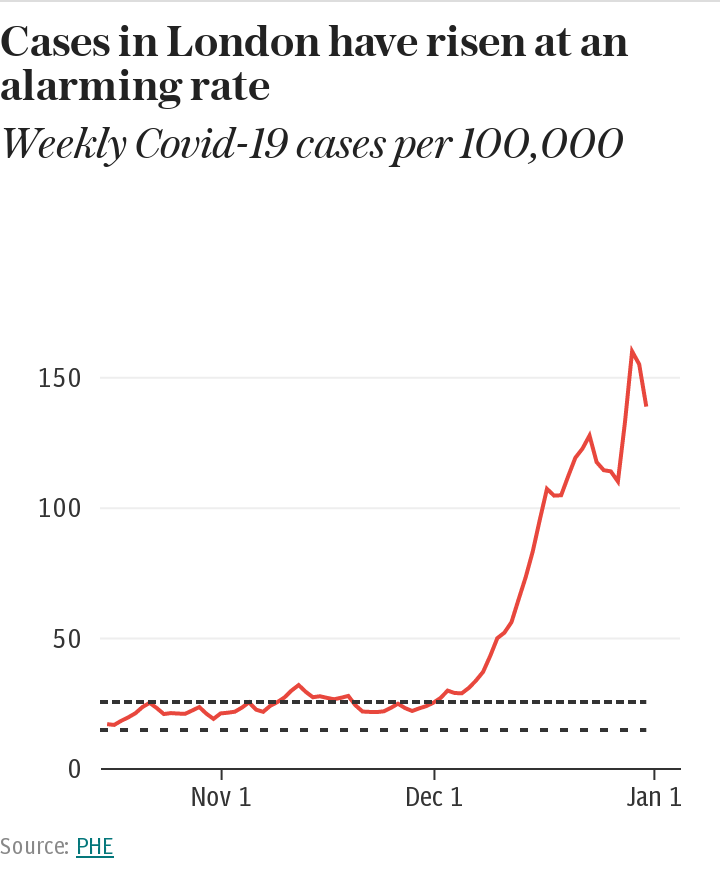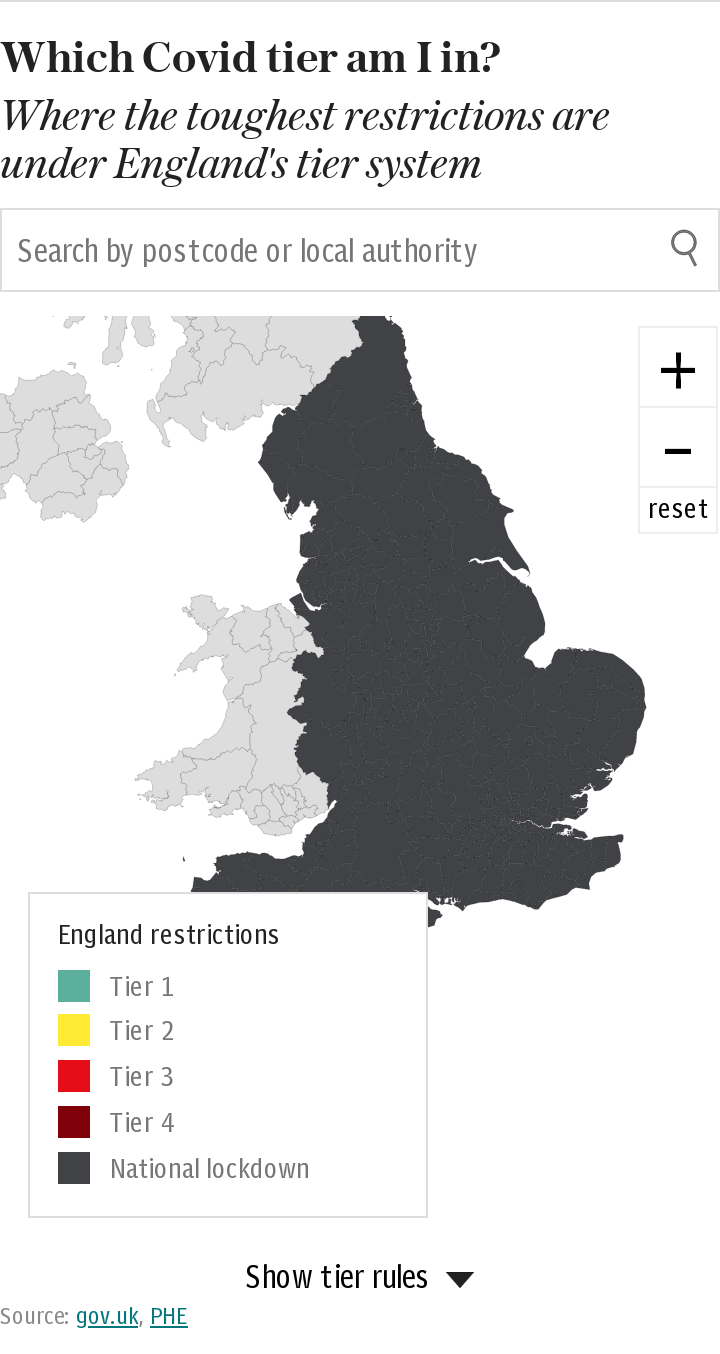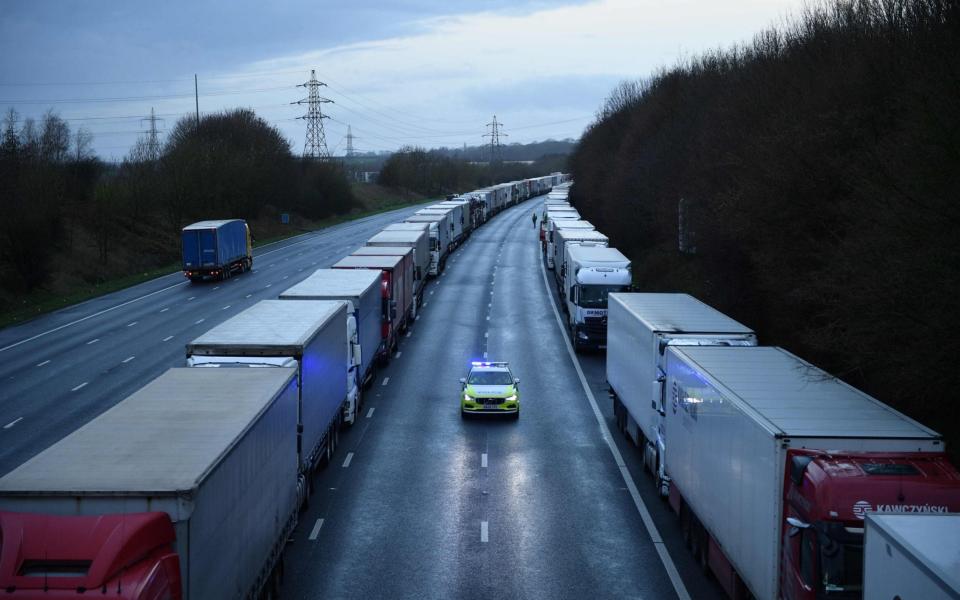Tier 4 lockdown: What are the latest rules, and which areas will move Tier on Boxing Day?


Tier 4 has been extended across parts of England as further areas face tightened restrictions from Christmas.
Speaking at a Downing Street press conference, Mr Hancock said: "From 00.01 on Boxing Day Sussex, Oxfordshire, Suffolk, Norfolk and Cambridgeshire, those parts of Essex not yet in Tier 4, Waverley in Surrey and Hampshire including Portsmouth and Southampton but with the exception of the New Forest will all be escalated to Tier 4."
Tier 4 was introduced in England for the first time to combat a new strain of coronavirus, with London and the South East plunged into restrictions "broadly equivalent" to a full lockdown on Dec 20.
Concerns about the threat posed by the new variant, which has fuelled soaring cases of Covid in London and the South East, led the Prime Minister to introduce the new Tier 4 for 16.4 million people, complete with orders to “stay home”.
Tier 4 means non-essential retail, hairdressers and indoor gyms are closed, and people are not be able to meet more than one person from another household in an outdoor public space.
Residents already in Tier 4 cannot celebrate Christmas with anyone outside their support bubbles and should not leave the tier.
Here's what we know about Tier 4 restrictions.
Read more: Christmas 2020 lockdown rules

Why do we need a Tier 4?
A new variant of Covid-19 up to 70 per cent more transmissible is spreading in London and the South East.
Cases of the new mutation of Covid grew “exponentially” during the November lockdown, the Government’s Nervtag committee minutes revealed, and even Tier 4 measures may not be able to stop its march.
The committee's assessments indicate the new variant could increase the reproduction rate (R) of the virus by as much as 0.93.
Matt Hancock confirmed on Dec 23 that two cases of a new variant had been identified in the UK. This second variant has been traced to South Africa, and the Health Secretary has stated that anybody who has travelled from South Africa in the last two weeks, or been in close contact with someone who has, must quarantine.
Which areas are in Tier 4?
As of Dec 23, several areas have joined the South East, East and London in Tier 4.
This includes:
All 32 London boroughs plus the City of London
Bedford, Central Bedfordshire, Luton and Milton Keynes
Berkshire (Bracknell Forest, Reading, Slough, West Berkshire, Windsor and Maidenhead, and Wokingham)
Buckinghamshire, Gosport, and Havant
Cambridgeshire
Essex
Hampshire including Portsmouth and Southampton but with the exception of the New Forest
Kent and Medway
Norfolk
Oxfordshire
Portsmouth, Hastings, Rother and Hertfordshire
Peterborough
Surrey
Suffolk
Sussex
Some local authorities in Hertfordshire (Broxbourne, Hertsmere, Three Rivers and Watford)

What are the rules in Tier 4?
Rules in Tier 4 are similar to those of the last national lockdown:
Pubs, bars and restaurants will only be able to serve takeaway
Hotels must close their doors
Indoor gyms and leisure centres must close
Personal care services and non-essential retail must close
People living in Tier 4 cannot bubble with other households over Christmas
Residents should stay at home as much as possible
Residents should not enter or leave Tier 4 areas unless for essential reasons
Residents from Tier 4 areas should not stay overnight in other areas
They cannot go abroad apart from "limited exceptions" such as work
People should work from home if they can
Communal worship may continue
Weddings and civil partnerships can only take place in exceptional circumstances, with a limit of six attendees
How are tiers determined?
Five categories are used to determine which level an area falls into:
The rate of infection, particularly among the over-60s
How quickly case rates are rising or falling
Positivity in the general population
Pressure on the NHS – including current and projected NHS capacity
Local context and exceptional circumstances such as a local but contained outbreaks
When could Tier 4 restrictions end?
The next review of local tier restrictions is expected to take place on December 30. These reviews determine whether areas will move down a tier, remain the same, or move up a tier.
Tier 4 restrictions could be toughened further and remain in place until close to Easter, Government sources have admitted.
Ministers believe at least 20 million people will need to have been vaccinated against coronavirus before any significant relaxing of the measures can be considered, it is understood.
Matt Hancock said on December 20 that Britain faces a “very difficult” few months, warning that the spread of the virus across swathes of England is now “out of control”.
Tory MP Mark Harper, the chairman of the Covid Recovery Group (CRG), described the changes as a “a very sad day” for the country and demanded that Mr Johnson come forward with a “clear exit strategy from this nightmarish cycle of damaging lockdowns and restrictions.”
“Lockdowns and increasingly severe tiered restrictions have failed in their goal of slowing the transmission of Covid,” he added.
“And now the Government is expecting people to sacrifice the chance to share Christmas with family, friends and loved ones, just a few days after promising the opposite.”
Read More: What exactly is the Pfizer vaccine, who will get it, and is it safe?
Travel, holidays and work
Anyone living in a Tier 4 area will not be allowed to leave to travel to lower-prevalence cities, towns and villages.
Those who have booked holidays abroad will also need to cancel them, with Mr Johnson stating that the only foreign travel permitted will be for workers who have a business exemption. Anyone returning home would still have to quarantine.
Mr Johnson urged people to "carefully consider whether they need to travel abroad." No outright ban was indicated, as per the first lockdown.
The WHO have called on its members in Europe to step up their own measures against coronavirus in the face of the new variant circulating in Britain.
The first to do so was the Dutch government, which banned all passenger flights from Britain until January 1 after finding a case in the Netherlands of the new coronavirus strain.
Belgium has imposed a 24-hour ban on flights and rail links while it assesses the situation.
Italy is prohibiting entry to the country by anyone who had been in the UK in the last 14 days while flights are banned until January 6.
Austria and the Czech Republic are also imposing restrictions, with Prague announcing stricter quarantine rules with anyone arriving in the country having spent at least 24 hours in UK territory required to self-isolate.
Austria and Italy have not specified when their plans to halt flights from the UK would take place.
Ireland and France have imposed a 48-hour travel ban from the UK. Those restrictions will come into force at midnight on Dec 20.
The German government have implemented a travel ban on flights from the UK as of midnight (Berlin time) on Dec 20 and will remain in place until at least Dec 31.
Spain said that in response to the moves by some of its European Union partners, it had asked the European Commission and the European Council for a coordinated community response to the new situation.
A No 10 spokesperson said: "The Prime Minister will will chair a COBR meeting tomorrow (Dec 21) to discuss the situation regarding international travel, in particular the steady flow of freight into and out of the UK. Further meetings are happening this evening and tomorrow morning to ensure robust plans are in place."
Professor Chris Whitty, England’s chief medical officer, told the Downing Street press conference that anyone in Tier 4 who had begun packing their bags for Christmas should now “unpack” them.
Exemptions to the "stay at home" message which applied in the November lockdown, will also apply in the new Tier 4 - including support bubbles, childcare bubbles and children whose parents are separated.
People will be allowed to travel for education, childcare and to go to work if they cannot work from home and they will be permitted unlimited outdoor exercise.

Non-essential retail and hospitality
All non-essential stores in Tier 4 areas are being forced to close, meaning people who have yet to finish their Christmas shopping will need to move quickly to purchase presents online.
In a hammer blow to the high streets of London and towns across the South East, the return to lockdown-style closures will affect fashion and department stores, toy, gadget and electrical shops.
Supermarkets, green grocers, newsagents and corner shops will remain open. Stores in lower tier areas will be unaffected by the changes.
Mr Johnson was unable to say whether additional financial support would be provided by the Treasury.
Helen Dickinson, chief executive of the British Retail Consortium, said: "The consequences of this decision will be severe.
“For businesses, the Government's stop-start approach is deeply unhelpful - this decision comes only two weeks after the end of the last national lockdown and right in the middle of peak trading which so many are depending on to power their recovery.
"Faced with this news - and the prospect of losing £2 billion per week in sales for the third time this year - many businesses will be in serious difficulty and many thousands of jobs could be at risk.”
Pubs and restaurants will remain shut in Tiers 3 and 4, except for takeaway. In Tier 2 last orders are 10pm with closing time at 11pm, and you can only dine with people in your own household. In Tier 1, rule of six applies indoors.
Personal care and entertainment
Hairdressers, other close personal care services have also been closed in Tier 4, including beauticians, nail salons and tattoo shops.
The restrictions will also apply to entertainment venues such as cinemas, bowling alleys, bingo halls, casinos, indoor skating rinks and amusement arcades.
The changes mirror the two previous lockdowns.
The changes will not affect lower tiers in England, although Mark Drakeford, the Welsh First Minister, has confirmed that they will also apply as part of Wales’s post-Christmas lockdown due to come into effect on December 20.
Gyms and leisure centres
Just weeks after reopening, gyms and leisure centres have been shut again in areas placed into Tier 4.
Outdoor sports courts, outdoor gyms, golf courses, outdoor swimming pools, archery/driving/shooting ranges, riding centres and playgrounds can remain open for individual exercise, and for people to use with others within your household, support bubble, or with one person from another household. Organised outdoor sport for under 18s and disabled people will be allowed.
The measures announced do not appear to have any impact on professional sport, as spectators are still not allowed to enter stadiums and other sporting venues in Tier 3.
The changes do not affect lower tiers, meaning people can continue to use gyms and leisure centres.
Professional football, rugby and other matches will still take place with limits on crowd sizes, which are a maximum of 4,000 in Tier one, dropping to 2,000 in Tier two.
Churches
People will still be able to attend Christmas services and midnight mass in all areas of the country, although it is thought that those in Tier 4 will have to remain within their own households.
In the lower tiers, people attending church will be required to observe the restrictions on household mixing indoors as set out for their tier.
The decision to keep places of worship open for communal worship differs from previous lockdown restrictions, with Government sources stating that they recognise the importance that religion plays for many people at Christmas.
Weddings
Couples in Tier 4 will now be forced to postpone their plans unless they meet an exceptional circumstances exemption, which normally only applies for someone who does not have long to live.
However, in the lower tiers people will still be able to tie the knot, albeit with strict limits on their size.
Under the Government’s ‘Covid Winter Plan’, civil partnerships and wedding ceremonies can go ahead with up to 15 guests and under social distancing requirements. However, receptions remain banned in Tier 3.
Shielding
People who were asked to “cocoon” themselves at home for weeks on end could be asked to do so again, Prof Whitty indicated.
While the Government relaxed the rules due to concerns over the impact on people’s mental health, the chief medical officer revealed that the guidance around shielding was now being reviewed as the virus continues to surge.
“The shielding patterns are actually being re-looked at,” he told the Downing Street press conference.
"The view about shielding is that, in the first wave, shielding did many things that were useful but also did many things that were actually actively harmful.
"And we therefore changed the model of shielding since the first wave, and that includes people being able to get out more in many situations, and also areas around work.
"But this is something which people are keeping on looking at, to try and get the optimal balance between isolating people too much and isolating them enough from the virus."
Schools
Pupils will be asked to continue attending school in all tiers, despite growing concern that children and teenagers are contributing to a surge in cases in the South East.
Downing Street confirmed that schools in Tier 4 areas are still expected to reopen after the Christmas holidays.
However, like lower tiers, they will also be required to stagger the return of secondary school and college pupils during the first week of January while mass testing is rolled out.
Under the plans, announced earlier this week, only pupils in Year 11 and Year 13 who are preparing for GCSEs and A-levels will be allowed back as usual on Jan 4.
Do you have any questions on Tier 4 restrictions or the new coronavirus strain? Email yourstory@telegraph.co.uk and your questions will be answered by our experts.

